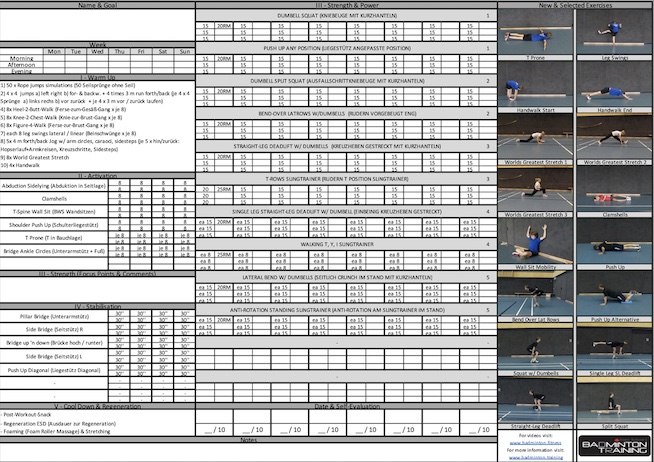Strength Training at Home for Badminton - Part 2
In Part 1 we constructed a structure for a strength training program - now we are proceeding to fill it with life: exercises and more thoughts on building the perfect home training plan.
Before coming to the actual program, a few more important thoughts: the basic structure represent a whole body strength program for Badminton that also can be used in other quadriceps-dominant overhead-sports like e.g. Tennis or Volleyball - new we have to impliment or make room for individual adaptations.
Individualisations can be made in different ways.
First of all it needs to be done when defining training intensity and volume, that is to say weights, sets and reps. The good thing here, training intensity can also be defined by defining the weights via repitition maximum (RM). 1-3 RM represents 100-90% intensity where intramuscular strength is targeted, the classic hypertrophy training that is normally 70-85% intensity would be the 8-12 RM range. E.G. 12 RM stands for the maximum weight, that one can overcome 12 times without the technique or safety is compromised. By using RM, individuality is given by definition.
Second thing is individual weaknesses. The Badminton program I will present will contain the typical weak points of a Badminton player already that can be adressed with proper strength training. We will also target those in the warm up and activation part - by doing this, another step in individualisation has been gone. For the interested reader who wants to dig deeper into the topic, consider the article "A suprising FMS result in Badminton players".
Another important points is individual contraindications like previous injuries - if these are present please consult a doctor and asked an experience Rehab or/and S&C coach for help in designing your strength training program.
At the end of the strength training and additional core stability routine can be implimented. As the main part of the strength training will already contain a lot of impact or demand for stability, we will mainly target the front and lateral core muscles, as these are normally weaker for Badminton athletes. We also know from scientific studies that dynamic stabilisation exercises already start the "cool down" processes and therefore help with regeneration at the end of the session. It can be followed up with additional light ESD as well as Foam roller and stretching exercises - this can also be done in an extra session later or the next morning, if you have the time to do so that will allow more impact of the strength training session itself regarding adaptationss.
Now let's cut to the chase:
The plan can look like the following (NEWSLETTER subscribers will get the program as PDF) and will work with minimal equipment (only dumbells and sling trainer used). If you can at a barbell at a later point, this would be perfect. Some of the exercises are highlighted and linked to my YouTube channel:
Warm Up with a duration of 8-12 min
- for examples please see this playlist
Activation (each exercises twice with 8 reps)
- T-Spine Mobilisation Walldrill
- Shoulder Push Up
- Plank or Pillar Bridge with Ankle Circles
- T prone
Strength (1-3 set à 8-15 reps (see Part 3 for more details))
1.1 Exercise: Lower Body Push: Kniebeuge mit Kurzhanteln
1.2 Exercise: Upper Body Push horizontal: Push Ups
2.1 Exercise: Lower Body Push: Split Squat with Dumbells
2.2 Exercise: Upper Body Pull vertical: Latzugrudern am Slingtrainer
3.1 Exercise: Lower Body Pull: Straight Leg Deadlift
3.2 Exercise: Upper Body Pull horizontal: Rows lingtrainer (easier vVersion)
4.1 Exercise: Lower Body Pull: One-Leg Straight Leg Deadlift
4.2 Exercise: Upper Body Pull horizontal: Walking T Slingtrainer
5.1 Exercise: Core Lateralflexion: Side Crunch Standing w/ Dumbells
5.2 Exercise: Core Anti-Rotation: Anti-Rotation w/ Slings isometric
Stabilisationszirkel
- E.g. "Around-the-World" (Varianten von Unterarmsütz, Side bridge right, Bridge, Side bridge left, Push Up Diagonal)
This is how to go through the program: Do the warm up and activation then progress to the strength part and go through this in mini circuits, that mean do 1 set of exercises 1.1., then 1 set of 1.2., then the second of 1.1. and so one. Give yourself 45-60 secs pause between each exercises. In the end, do the stabilisastion circuit for 30-45 sec per exercises for three times. In a PDF plan this looks like the following:
More to sets and reps in Part 3. The PDF plan is already send to each Newsletter subscribers and will be send to each new one as well. To subscribe klick here: FREE NEWSLETTER
Diemo RuhnowSign up for our monthly newsletter and you be the first to know about new stuff on the site and get EXCLUSIVE content, sign up here for our FREE NEWSLETTER !




